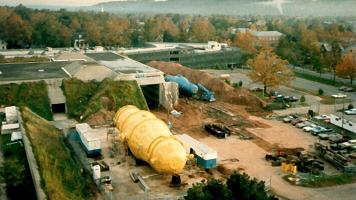Accelerator physics has a long and distinguished history at Yale. The concept underlying the cyclotron was dreamt up by Earnest Lawrence in 1926, when he was an instructor at Yale. A version of Lawrence’s cyclotron was built at Yale in the ‘30’s by Earnest Pollard and Howard Schultz. An early linear accelerator (linac) for electrons was built at Yale in the ‘40’s by Schultz and Carol Montgomery, and a heavy ion linac was designed and built at Yale in the ‘50’s by Robert Beringer and others. That machine began to turn out physics results in 1958. But arguably the most significant Yale contributions to on-campus accelerator-based physics came in the ‘60’s with D. Allan Bromley’s tandem Van de Graaff heavy ion accelerator, commissioned in 1964, that formed the heart of the Yale Arthur W. Wright Nuclear Structure Laboratory WNSL.  That machine, together with its larger successor, is credited with turning out nuclear physics Ph.D’s in numbers that exceeded those from any other American university. It was decommissioned in 2012, as WNSL morphed into Wright Laboratory, Yale’s preeminent facility for a wide range of experimental studies of rare nuclear events that underlie the fundamental structure of the universe.
That machine, together with its larger successor, is credited with turning out nuclear physics Ph.D’s in numbers that exceeded those from any other American university. It was decommissioned in 2012, as WNSL morphed into Wright Laboratory, Yale’s preeminent facility for a wide range of experimental studies of rare nuclear events that underlie the fundamental structure of the universe.
 The Yale Beam Physics Laboratory BPL was founded by Jay Hirshfield in 1992, by refurbishing the shielded vault space that had housed the electron linac. BPL projects have thus bridged the transition from Yale’s 80-year long on-campus accelerator-based physics programs to studies that seek to discover new mechanisms to accelerate charged particles, and the technological advances needed to apply these mechanisms. More recently, BPL is also working to apply principles and technologies from accelerator science that can either support the wider scientific goals of Wright Laboratory, or that can be applied to practical areas such as remediation of environmental pollutants. Since its founding, BPL has spawned three Ph.D’s, eight postdocs, and over 150 archival research publications. Descriptions of the major experimental facilities within BPL and examples of some current BPL projects are described here.
The Yale Beam Physics Laboratory BPL was founded by Jay Hirshfield in 1992, by refurbishing the shielded vault space that had housed the electron linac. BPL projects have thus bridged the transition from Yale’s 80-year long on-campus accelerator-based physics programs to studies that seek to discover new mechanisms to accelerate charged particles, and the technological advances needed to apply these mechanisms. More recently, BPL is also working to apply principles and technologies from accelerator science that can either support the wider scientific goals of Wright Laboratory, or that can be applied to practical areas such as remediation of environmental pollutants. Since its founding, BPL has spawned three Ph.D’s, eight postdocs, and over 150 archival research publications. Descriptions of the major experimental facilities within BPL and examples of some current BPL projects are described here.
